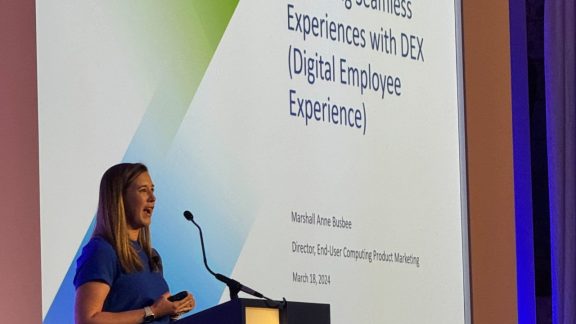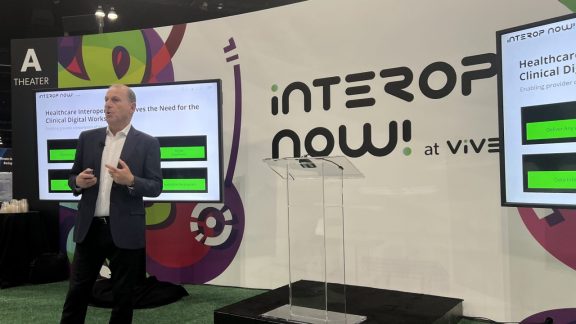By Kevin Goodman, director product management, End-User Computing, VMware
Today at VMworld 2011 in Las Vegas we are excited to announce VMware View 5. The newest version of View continues to help IT organizations empower a more agile, productive and connected enterprise by enabling a better desktop.
One of the more anticipated features of VMware View 5 Premier Edition – View Persona Management – preserves user profiles and dynamically synchronizes them with a remote profile repository. By preserving the user's profile between sessions, View Persona enables IT administrators to provide a floating pool to users who previously required their own dedicated desktop. With this blog, I would like to provide you with a bit more information on this exciting feature.
“Difficulty in managing user profiles is the second most prevalent challenge in implementing virtual desktops. (after licensing costs)”– Desktops as a Service, The Changing Face of Desktop Virtualization, 12/2010, Rachel Chalmers, The 451 Group.
Rachel’s words from last year are still relevant today and with the introduction of View 5 many of the most prevalent challenges have been eliminated.
As you probably know, a user profile is the collection of data and configuration settings that comprise each user’s Windows session. In Windows XP, the profile is stored by default in the <c:\documents and settings\%username%\ directory>. In Windows Vista and 7 the default directory is <c:\users\%username%>. User profiles comprise a variety of user-generated information:
- User-specific data and desktop settings, which allow the desktop appearance to be the same regard less of which desktop a user logs in to.
- Application data and settings. For example, these settings allow applications to remember toolbar positions and preferences.
- Other Windows registry entries configured by user applications.
So what about managing a user’s profile is so challenging?
Persisting profile changes…
- In a traditional physical desktop with local storage all of the changes a user makes to their profile are stored on the local hard disk in their profile. In the virtual world, desktops come in two flavors: dedicated desktops (also known as persistent desktops) in which users get assigned a specific desktop and use that desktop each time the logon; and, floating desktops (also known as non-persistent) which provide the user a random desktop for each session.
In either flavor administrators have to decide how to handle the user’s profile. Dedicated desktops store the user’s profile on the Persistent Data Disk. Persistent Data Disks, however, are not an optimal solution for Business Continuity / Disaster Recovery scenarios (BC/DR). Persistent Data Disks also do not integrate well with enterprise backup solutions.
- Floating desktops have a different challenge with respect to profiles. Floating desktops revert back to their original state upon logoff. This means the user would lose all of their profile data logoff. On the subsequent logon floating desktop user’s have the experience of a person logging on for the first time to Windows: their desktop background would be set to the default wallpaper and they would have to configure each application's preferences all over again.
That’s why we have incorporated Persona Management into View 5. Persona Management is a feature that seamlessly preserves a user’s profile on to a network share for safe keeping between sessions in either floating or dedicated desktops. The key word is seamlessly. Persona persists data and settings stored in the profile without specific knowledge of how a particular application works. In fact, there is only one mandatory option for persona – to turn it on!
But that is not all. View Persona Management also minimizes the time it takes to log on and log off desktops.
- During login, View down loads only the files that Windows requires, such as user registry files. Other files are copied to the View desktop when the user or an application opens them from the profile folder in the View desktop.
- With View Persona, during logoff, only files that were updated since the last replication are copied to the remote repository.
Another nice feature of View Persona Management is that no changes to Active Directory User Object are required in order to have a managed profile. To configure View Persona Management, you specify a central repository. Having this central repository also allows you to manage a user's profile in one environment without affecting the physical machines that users might also log in to.
With View Persona Management, if you provision desktops with VMware ThinApp applications, the ThinApp sandbox data can also be stored in the user profile. This data can roam with the user but does not significantly impacting logon times and provides better protection against data loss or corruption.
The great thing about VMware View is that simplifies IT management, while increasing security and control of end user computing and decreasing costs by centrally delivering desktop services from your private cloud. VMware View enables highly available, scalable, secure and reliable desktop services unmatched by physical PCs. VMware View with PCoIP delivers the highest fidelity experience to users across devices and networks and enables a rich, personalized access to desktop services like applications, unified communications and 3D graphics for real world productivity. IT administration is quick and efficient allowing fast response to changing business requirements.
And now with View Persona Management, users will have a consistent desktop experience from logon to logon regardless of whether they are in a floating or dedicated pool.
Let us know if you have any questions via the comments section below. We will do our best to answer quickly.
Read the VMware View 5 Media Backgrounder here. Screen Shots of View 5 can be found here.







